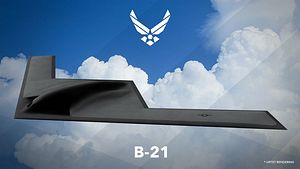The U.S. Air Force’s future B-21 “Raider” long-range strategic bomber is being produced in Northrop Grumman’s production facility in Palmdale, California, the Acting Secretary of the Air Force, Matthew Donovan, announced on September 16. Donovan also said that the development of the B-21 is on schedule. The acting secretary of the Air Force spoke at the Air Force Association’s Air, Space, and Cyber Conference, which took place yesterday at National Harbor, Maryland.
“[T]he development of the B-21 Raider is on schedule and the first test aircraft is under production at the same production facility in Palmdale, California, as its predecessor, the B-2,” he was quoted as saying in a USAF press statement. “The first flight of the Raider will take it from Palmdale to Edwards AFB, where the legacy of excellence will continue with the reactivation of the 420th Flight Test Squadron.”
The bomber is reportedly being assembled at the Air Force Plant 42 outside Palmdale, California, as The Diplomat reported in July.
The B-21 program has reportedly entered into its Engineering Manufacturing and Design phase in early 2019. This program phase involves developing and designing the bomber, including completing full system integration, before going into production.
Northrop Grumman was awarded a contract in October 2015 covering the Engineering and Manufacturing Development (EMD) phase, as well as the first five production lots to cover the production of the first 21 bombers. “The program has a mature and stable design and is transitioning to manufacturing development of the first test aircraft in Palmdale,” according to the USAF.
In July, the USAF Vice Chief of Staff, General Stephen Wilson, indicated that the B-21 will make its maiden flight sometime in December 2021.
The B-21 will most probably be a subsonic long-range bomber featuring a flying wing design and capable of carrying both conventional and nuclear weapons. It will also reportedly be optionally manned.
The bomber will most likely be armed with the Massive Ordnance Penetrator bomb, the B-61-12 thermonuclear gravity bomb, and the Long Range Stand Off (LRSO) nuclear-capable cruise missile.
“The B-21 will be a highly survivable, next-generation bomber with the ability to penetrate modern air defenses and hold any target at risk globally,” the USAF notes.
Specific details around the bomber’s technical specifications and capabilities, however, remain classified.
“The Air Force continuously evaluates the B-21 program security posture with input from the intelligence community and is committed to maximizing transparency of key program information while balancing the need to protect vital technologies and capabilities from adversary exploitation,” according to the September 16 statement.
The B-21 will replace the USAF’s B-1B Lancer, B-2 Spirit, and B-52H fleets. The service plans to procure at least 100 B-21s, at a cost of $656 million each in 2019 dollars.































